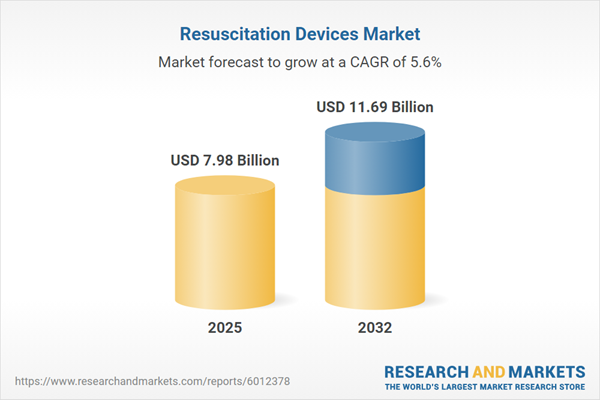Speak directly to the analyst to clarify any post sales queries you may have.
The resuscitation devices market is evolving rapidly, driven by healthcare sector priorities in clinical safety, technology adoption, and compliance. Senior decision-makers are seeking actionable strategies to enhance readiness and enable effective deployment of advanced emergency medical equipment.
Market Snapshot: Resuscitation Devices Market Size and Outlook 2024
The global resuscitation devices market is currently valued at USD 7.56 billion in 2024. Growth continues at a CAGR of 5.59%, reflecting sustained demand in acute care settings and the increasing need for advanced technologies. Changes in regulations are compelling manufacturers to prioritize product innovation and compliance-driven upgrades, ensuring that devices meet evolving intervention protocols. As both public and private healthcare organizations invest strategically in this sector, the capacity to deliver timely and effective emergency care has become a central focus. This dynamic market environment is accelerating access to integrated resuscitation solutions, influencing procurement and standardization efforts worldwide.
Scope & Segmentation in the Global Resuscitation Devices Market
This report is structured to provide senior executives with targeted intelligence for improving procurement decisions, driving operational efficiency, and leading technology adoption. Analyzing clear market segments empowers leaders to evaluate opportunities and risks across the primary pillars of the global resuscitation devices market.
- Device Types: Automated external defibrillators, implantable cardioverter defibrillators, manual external defibrillators, and wearable cardioverter defibrillators each address unique patient needs. This diversity supports robust emergency protocols as well as ongoing patient monitoring.
- Applications: Use includes cardiac arrest management, pacing support, cardioversion, and both invasive and non-invasive respiratory interventions. Each application ensures patient stability during transitions and throughout acute or chronic episodes.
- End User Profiles: Hospitals, ambulatory care centers, specialty clinics, emergency response teams, and homecare providers each bring specific operational needs that shape procurement plans and integration methods for new resuscitation technologies.
- Sales Channels: Direct sales, distributor networks, and digital procurement solutions each ensure timely delivery and strengthen supply chains in varied healthcare environments.
- Regional Markets: In-depth analysis covers North America, Europe, Asia-Pacific, the Middle East, and Africa, revealing adaptative regulatory response and distinct market entry patterns in countries such as the U.S., Germany, China, Canada, and India.
- Leading Companies: Profiles of major companies—Koninklijke Philips N.V., Medtronic plc, ZOLL Medical Corporation, Nihon Kohden Corporation, Drägerwerk AG & Co. KGaA, Ambu A/S, Becton, Dickinson and Company, Teleflex Incorporated, Smiths Group plc, and Mindray Medical International Limited—highlight innovation, technology leadership, and compliance initiatives that set benchmarks across the industry.
Key Takeaways for Senior Decision-Makers
- Deployment of portable and digitally connected resuscitation devices enables responsive care across multiple sites, supporting rapid intervention and streamlined resource allocation regardless of organization scale.
- Incorporation of artificial intelligence into device platforms improves clinical protocol consistency and supports more accurate, data-informed decision-making during emergencies.
- Expansion of simulation-based training programs increases operational proficiency by enabling clinicians and first responders to confidently apply best practices under varying scenarios and patient demands.
- User-centered product development reduces complexity, accelerates onboarding, and minimizes human error, supporting safer and more consistent use among varied user groups.
- Procurement priorities are shifting toward modular and adaptable solutions, ensuring organizations remain compliant and resilient as regulatory requirements and clinical standards evolve.
- Flexible technology platforms help organizations respond quickly to shifting patient needs and regulatory frameworks, providing adaptability in an ever-changing clinical environment.
Tariff Impact on Supply Chains and Market Access
Upcoming changes to U.S. tariffs in 2025 are prompting device manufacturers to reassess sourcing strategies and invest in regional supply models. For healthcare procurement leaders, this transition supports improved device availability and supply resilience while reducing the challenges of regulatory realignment. Organizations can expect streamlined sourcing and enhanced risk management as new tariff structures are implemented.
Methodology & Data Sources
Analysis in this report is based on structured interviews with clinicians, procurement executives, and supply chain professionals. Qualitative feedback is combined with rigorous review of regulatory frameworks, industry publications, and proprietary market data to deliver actionable guidance and reliable insight for senior leaders.
Why This Report Matters for B2B Market Leaders
- Thorough segmentation and actionable regional insights enable strategic resource planning, precise market entry strategies, and agile responses to compliance and operational demands.
- Timely intelligence helps organizations benchmark progress, identify optimal technology partnerships, and inform investment decisions aligned with industry development and workflow optimization.
Conclusion
This report guides leaders in advancing resuscitation device innovation, enhancing organizational readiness, and fostering adoption across diverse health systems. Insights presented support proactive planning and resilience as the market landscape evolves.
Additional Product Information:
- Purchase of this report includes 1 year online access with quarterly updates.
- This report can be updated on request. Please contact our Customer Experience team using the Ask a Question widget on our website.
Table of Contents
3. Executive Summary
4. Market Overview
7. Cumulative Impact of Artificial Intelligence 2025
Companies Mentioned
The companies profiled in this Resuscitation Devices market report include:- Koninklijke Philips N.V.
- Medtronic plc
- ZOLL Medical Corporation
- Nihon Kohden Corporation
- Drägerwerk AG & Co. KGaA
- Ambu A/S
- Becton, Dickinson and Company
- Teleflex Incorporated
- Smiths Group plc
- Mindray Medical International Limited
Table Information
| Report Attribute | Details |
|---|---|
| No. of Pages | 187 |
| Published | October 2025 |
| Forecast Period | 2025 - 2032 |
| Estimated Market Value ( USD | $ 7.98 Billion |
| Forecasted Market Value ( USD | $ 11.69 Billion |
| Compound Annual Growth Rate | 5.5% |
| Regions Covered | Global |
| No. of Companies Mentioned | 11 |









